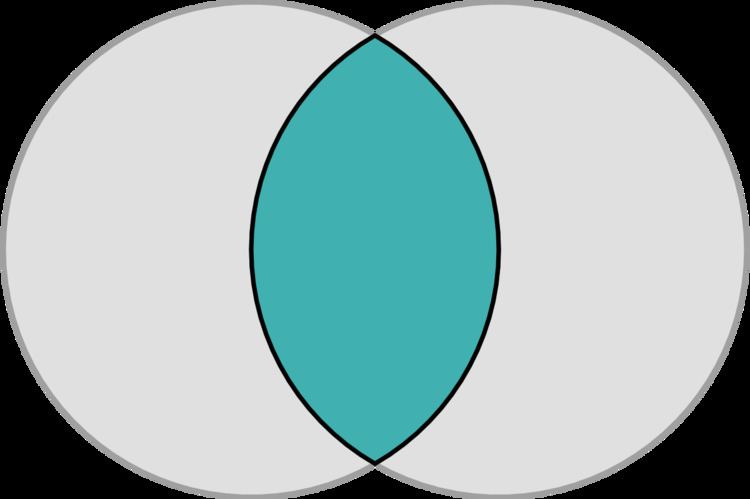 | ||
The vesica piscis is a shape that is the intersection of two disks with the same radius, intersecting in such a way that the center of each disk lies on the perimeter of the other. The name literally means the "bladder of a fish" in Latin after the conjoined dual air bladders ("swim bladder") found in the bodies of most fishes. The shape is also called mandorla ("almond" in Italian).
Contents
This figure appears in the first proposition of Euclid's Elements, where it forms the first step in constructing an equilateral triangle using a compass and straightedge. The triangle has as its vertices the two disk centers and one of the two sharp corners of the vesica piscis.
Mathematical description
Mathematically, the vesica piscis is a special case of a lens, the shape formed by the intersection of two disks.
The mathematical ratio of the height of the vesica piscis to the width across its center is the square root of 3, or 1.7320508... (since if straight lines are drawn connecting the centers of the two circles with each other and with the two points where the circles intersect, two equilateral triangles join along an edge). The ratios 265:153 = 1.7320261... and 1351:780 = 1.7320513... are two of a series of approximations to this value, each with the property that no better approximation can be obtained with smaller whole numbers. Archimedes of Syracuse, in his On the Measurement of the Circle, uses these ratios as upper and lower bounds:
Area
The area of the vesica piscis is formed by two equilateral triangles and four equal circular segments. In the drawing one triangle and one segment appear in blue.
One triangle and one segment form a sector of one sixth of the circle (60°). The area of the sector is then:
Since the side of the equilateral triangle has length r, its area is
The area of the segment is the difference between those two areas:
By summing the areas of two triangles and four segments, we obtain the area of the vesica piscis:
Uses
The two circles of the vesica piscis, or three circles forming in pairs three vesicae, are commonly used in Venn diagrams. Arcs of the same three circles can also be used to form the triquetra symbol, and the Reuleaux triangle.
In Christian art, some aureolas are in the shape of a vertically oriented vesica piscis, and the seals of ecclesiastical organizations can be enclosed within a vertically oriented vesica piscis (instead of the more usual circular enclosure). Also, the icthys symbol incorporates the vesica piscis shape.
Ecclesiastical heraldry of the Catholic Church appeared first in seals, nearly all vesica-shaped.
The cover of the Chalice Well in Glastonbury (Somerset, United Kingdom) depicts a stylized version of the vesica piscis design (see picture).
The vesica piscis has been used as a symbol within Freemasonry, most notably in the shapes of the collars worn by officiants of the Masonic rituals. It was also considered the proper shape for the enclosure of the seals of Masonic lodges.
The vesica piscis is also used as proportioning system in architecture, in particular Gothic architecture. The system was illustrated in Cesare Cesariano's Vitruvius (1521), which he called "the rule of the German architects".
